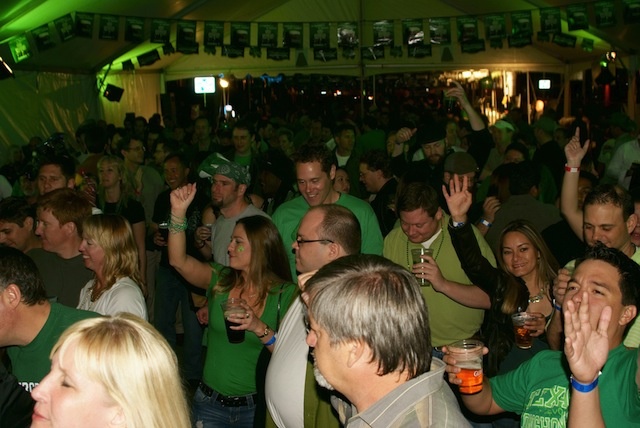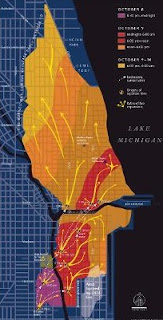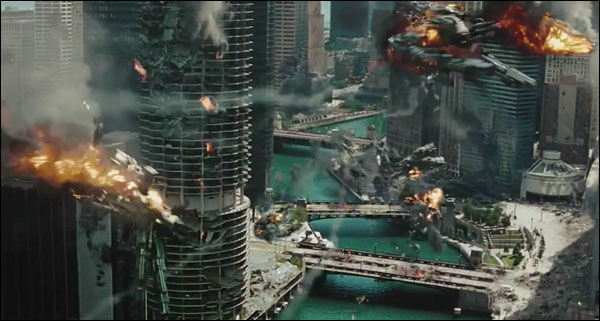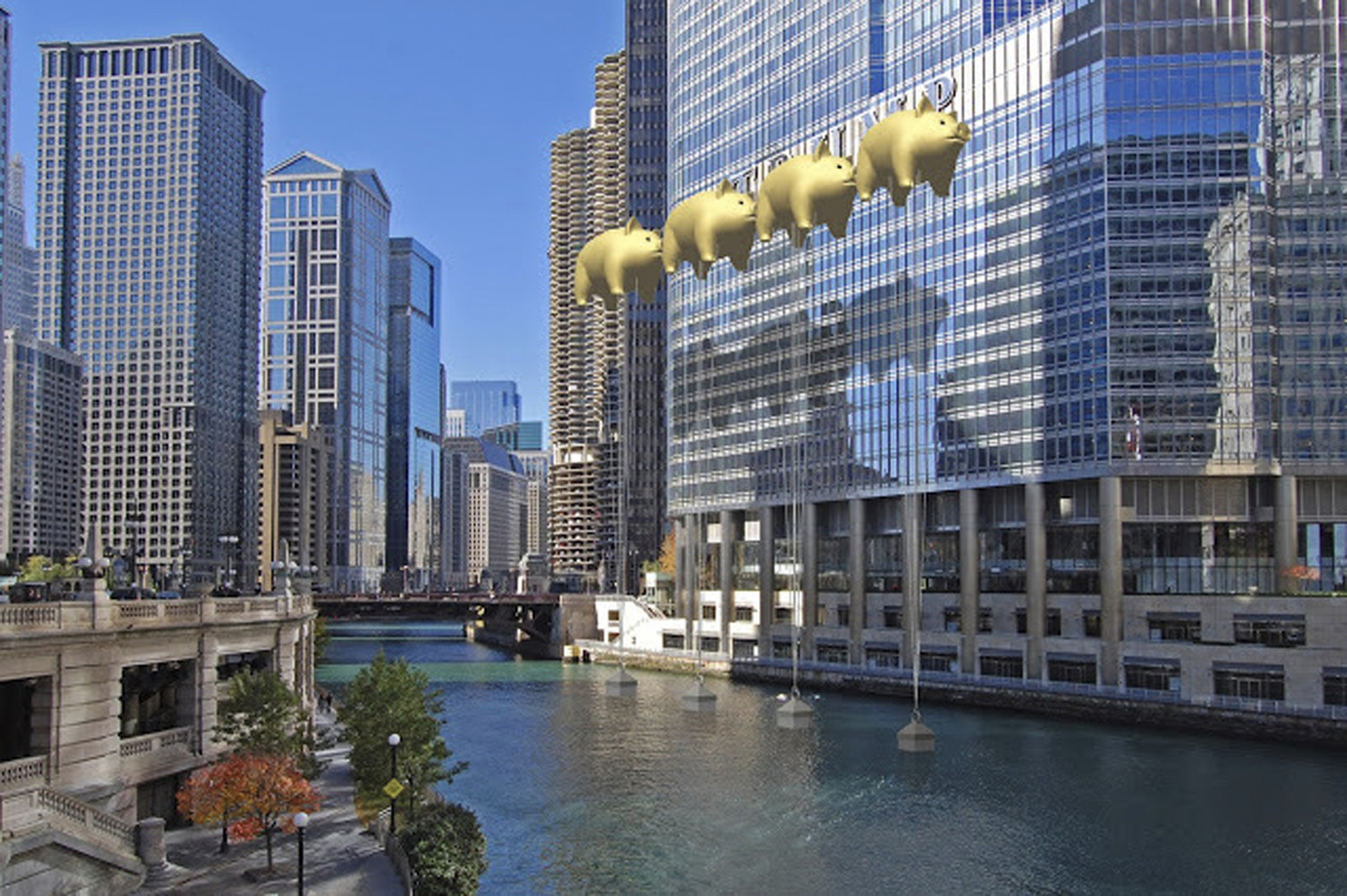|
Chicago river dyeing, March 11, 2017 |
One thing I'd like to do to kill time is bringing the picture above to people around, give the year, and see if they can tell the place & date it was taken. Many experienced travelers do. While I don't count it if he or she is an US citizen.
Indeed, Chicago river dyeing on St. Patrick's day won this none- official holiday much greater public attention worldwide than it would have otherwise, a must see event in central US. Originally a religious feast day in observance of the death of an Irish patron saint, St. Patrick's day has later on evolved into a public holiday in Ireland and now days widely recognized and celebrated among global Irish communities as well as the countries they residence, especially North America. In an immigrants formed country like US, settlers from each ethnic group usually bring in their distinct culture heritages when arrived, preserved, and kept introducing these traditions into greater american communities over generations. When enough time passed, some of these traditions have been widely accepted across various ethnic groups, and eventually became a fabric of American culture; such was St. Patrick's Day.
An interesting fact about first generation immigrants is that, many of them became more proud of their original culture heritage after landed America and even would like to work harder to promote it than in homeland; so did Irish American. In 1737, they held the first ever St. Patrick's Day parade in Boston, 166 years earlier than Ireland in 1903. In the years followed, most of the major US cities joined Boston to start holding the parade, including Chicago in 1843. A St Patrick's day parade in early days was no different from any other holidays' such as Easter Day, Labor Day, and etc; not until 1962, when a chairman of Chicago's St Patrick's parade came up an amazing idea to change the whole thing.
Stemming from Irish tradition, people always like to green something to celebrate St Patrick's day; from wearing green clothes, launching green firework to dyeing their dogs, etc. One day when a Chicago guy Stephen Bailey was inspired by the water pollution tracing practice, that pouring green dye into sewer system to pin point where the waste was discharged in Chicago river, a great idea came into his mind about St Patrick's day parade: how about green a river?
|
St. Patrick's Day river dyeing, Chicago, March 17, 2012 |
Three months later, Chicago citizens were stunned by the beautiful Irish green river on 1962 St Patrick's day. 100 pounds of chemical was poured into the water, keep the river green for an entire week. This dyeing practice proved immediate popularity, hundreds of thousands of audiences flooded the banks to admire this cool river. Since then this dyeing tradition became an annual effort to kick off the St Patrick's Parade celebration, with the eco-friendly vegetable-dye replaced chemical originally used.
|
Chicago River Dyeing, March 11, 2017, Chicago |
Today, Chicago river dyeing remains a beloved tradition of Chicagoan, one of the most heavily attended events in US, with hundreds of thousands tourists attracted to visit Windy City during the entire Saint Patrick's Day Celebration week. What an idea.
Being an Irish for one day and lost yourself in the crowd along side Chicago river for a river dyeing can be incredible. On March 11, 2017, a cold and sunny morning, I found myself standing among the green crowd on the river bank, chilling, and yielding when a large vessel spreading dye into the river. Few smaller boats followed closely and made a snake move to churn the water. 30 minutes later, the entire river turns into splendid shinning Irish green. Nothing quite like it.
|
St. Patrick's Day river dyeing, March 17, 2012, Chicago |
Then it is all began. Large crowd started moving alongside the river, thrilling, talking and taking pictures; then heading east, jammed the Grand Park, where St Patrick's Day parade occurs.
|
Crowd for St. Patrick's Day Parade, Grand Park, Chicago, March 17, 2012 |
Chicago Saint Patrick's Day Parade is not much different than any other big, noisy, and crowded events, with plenty of Irish dancers, bagpipes, drum corps in tow.
|
St. Patrick's Day Parade, Chicago, March 17, 2012 |
People were all Irish at that moment. They dress in green, shamrock jewelries on head and green necklace at hand, waving hands hardly when floats or TV cameras passing by.
|
Saw this green guy in 2017 parade. Chicago, March 11, 2017 Credit to: www.timeout.com |
A hour passed, crowd started diminishing; not back home, but venture out to Irish Pubs for a St. Patrick's Day theme drink: Guinness.
|
A pub in St. Patrick's Day, Chicago credit to: www.youthfulbalance.net |
Euphoria continues, every bar a Irish pub. People drink, talk and dance until midnight; They will keep on doing this for a week or so, until another big parade taking place on the official St. Patrick's Day to put an end to the whole thing. At the moment when I drink my Guinness, the celebration is not over, it begins.
Chicago
|
Chicago skyline, March 11, 2017 |
Beyond St. Patrick's Day things, Chicago in itself is a charming place. Take a water front walk on a sunny day, you probably will be amazed by one of the most beautiful skylines in the world: tall and magnificent, boasts four of the most well known high-rises in US. Those buildings are homes to hundreds of headquarters of large organizations including 29 of future 500. Go club for a jazz is another must do here, Chicago has long been recognized as a major center of music in central States. Watch a Bulls NBA game, or navigate various museums in town also create so much fun... Being the third largest city in States after New York and LA, Chicago features all what constitutes a great american town: powerful economy, superior art and jazz, diversified population, splendid buildings, and remains a crucial transportation hub and finance center, nothing less than a world class metropolitan.
Architecture is what Chicago famous for. This city has long been the lab of architectural innovation, home to tens of prominent skyscrapers. When take a walking tour in Chicago loop, seriously I was a little bit astonished by the stylish and unique architectures in my first visit to Chicago, if not by size.
Chicago high-rises are well known for their originality. It was quite understandable, since this is a city reborn in ashes. The Great Chicago Fire ruined the entire downtown years ago and left nothing but a blank canvass. Engineers and architects reinvented the city later on, filled it with magnificent future style buildings, when fire erased everything and there is no past to consume with.
The Great Chicago Fire
|
Route of the Great Chicago Fire |
1871 was the year it happened. Chicago had grew significantly in size and population during the pre-fire decades with over 300,000 residences by then. That year the city had gone through an unusually hot and dry summer, exhausted the water supply and caused severe drought conditions in fall. In the evening of October 8th, a barn on southwest Chicago was caught on fire. It grew very quickly to out of control, and spread rapidly to north towards city center. The then Chicago was extremely vulnerable to fire: full of wooden buildings, streets and even sidewalks, and many houses with tarred roof for water resistance. As such that night the fire burned wildly block to block, and soon reached Chicago river shore.
While the river also failed to stop the blaze. Along side the bank there were lumber yards, timber houses and multiple bridges. Firefighters hoped that the river would be a natural firebreak, in a regular city it might be the case, but unfortunately not in Chicago. The city is quite well know for something else: Windy.
|
Chicago Fire Academy, March 17, 2012, Chicago |
Strong southwest wind blown the burning debris to the other side of the river, and by mid night downtown Chicago was on fire. The city center was burning violently throughout the following day, and when the fire was eventually put out by rainfall on October 10, downtown Chicago were gone. Fire destroyed an area of 4 miles in length and 1 km in width, killed 300, left 100,000 homeless, or one third of local population. It didn't burn down the entire city, just the best part.
City reconstruction started immediately. People decided to build a modern city on the downtown fire ruins, and designed vogue architectures built only by fireproof materials such as bricks, stones, or steels. In 1883, the world first skyscraper appeared in downtown Chicago. In the years followed, hundreds of newer, taller high-rises fully re-occupied the entire downtown core; In 1956, the Chicago Fire Academy was built on the very site where Great Chicago Fire begins.
I imagine if without the Great Fire, today's Chicago perhaps looks no different than upper Manhattan, chaotic, messy, and covered entirely by condensed old buildings. It's nothing but the fire aftermath made possible the Great Rebuilding, and inspired the Chicagoan to turn this city into a testing ground of leading edge architectures. The fire didn't destroy the city, it completes Chicago.
|
Chicago today, Millennium Park, Chicago, May 30, 2010 |
Today, most of these splendid buildings are standing side by side in a small section in downtown Chicago alongside Michigan Ave, roughly 1 mile in length, running from Chicago river on the south to Water Tower near Hancock on the north, an avenue that fully occupied by luxury commercial and residential skyscrapers, so stunning that was nicknamed as the 'Magnificent Mile'.
Magnificent Mile
|
Magnificent Mile Street View, Chicago, May 30, 2010 |
Magnificent Mile is Chicago's finest. Luxury boutique stands besides upscale hotels, high end office buildings mixes with ritzy condos; Walking on this grand boulevard, you feel no different than on 5th Ave or Champs-Elysees. Some notable landmarks in Magnificent Mile are:
John Hancock Center. A classical steel and glass skyscraper. Hancock is an ironic landmark of Chicago, 100 stories, 344 meters tall, with a muscular exterior featured unique X-shape patterns. This black high-rise was topped out in 1968, and was the then second tallest building in the world, after Empire State Building in New York. Hancock located towards the northern end of Magnificent Mile, with a famous observation deck on Flr 94. One of my favorite buildings in Chicago.
|
Hancock, Chicago, May 30, 2010 |
Tribune Tower. 141m, 36-story high-rise with a new-Gothic structure, a fashionite design in 1920's. This is one of the most famous buildings in Magnificent Mile, not by size or exterior, but its history. The original Tribune Tower was built in 1868, burned down in 1871 Great Fire, and rebuilt in 1922.
This building is the home of Chicago Tribune, formerly known as Tribune Publishing. The outside wall of it's ground floor embeds rocks and bricks from various well-known sites around the world including Chinese Great Wall.
Wrigley Building. First building to the south end of Magnificent Mile. Built on 1921, this is the first major office building to the north of Chicago river. Not anymore a splendid skyscraper today, while still quite well know for its history as the headquarter of Wrigley Company.
|
Wrigley Building (White one in the middle), Chicago, March 17, 2012 |
Marina City. Corn shape 65-story twin tower, completed in 1961. It's might not be too exaggerate to call it a city, since it is a mix-used building where you can find condos, hotels, offices, restaurants, bank, restaurant, theater, opera house, and so on... most of the stuff you can expect from a small city. First 19 floors are used as a giant parking lot, looks fancy from far:
|
Marina City, Chicago, March 16, 2012 |
Marina City is a popular choice to film Hollywood movies given its unique shape. Looks like this in <Transformer 5>
|
Copied image: Movie Transformer 5 |
Michigan Ave Bridge. South end of Magnificent Mile, at the very heart of downtown Chicago. Surrounding areas is one of the most well-know urban spaces in the world, like Time Square to New York. It witnessed many pivotal moments of Chicago history.
|
Michigan Avenue Bridge, Chicago, May 30, 2010 |
Chicago Water Tower. The firefighting water tower of old times, built in 1869. This is one of the very few lucky buildings that survived 1871 Great Fire. The tower located to the north of Magnificent Mile, very close to Hancock. It is now served as Chicago Tourism office, with a tiny park around it.
Trump Tower. Don't know why this building is rarely mentioned on travel websites even before 2016 election, although you can see it in most of the places in downtown Chicago. It's big and shining enough to draw on attention of everyone, just like its showy owner. It's said that Trump originally planned to build it into the tallest building in the world, but changed his mind after 911 attack. It end up with the 4th tallest in US today, 98-story, 357 meters at rooftop. A beautiful building anyway.
|
Chicago, May 30, 2010 |
Landmarks outside Magnificent Mile
Willis Tower. More well known as Sears Tower, one of the most ironic skyscrapers in American History, appearing on various movies, TV shows, websites and print medias. The building was completed on 1973, 108-story, 442 meters, the then tallest building in the world. It held that title for 25 years. The famous Skydeck located at 103 Flr, A million visitors a year.
|
Willis Tower, Chicago, May 30, 2010 |
Millennium Park is a place I love in Chicago. It is a Manhattan Central Park type of urban facility, with downtown CBD to the west, and Michigan lake to the east. An incredible park for people with busy mind to seek some peace time. The elegant design won wide praise since it's grand opening in 2004.
|
Chicago Skyline from Millennium Park, Chicago, May 30, 2010 |
The park was projected to be the most visited Chicago tourist attractions in 2017, expecting 25 million visitors by year end.
|
Millennium Park, Chicago, May 30, 2010 |
My favorite place in the park is a jelly-bean shaped stainless steel sculpture, 'The Bean'. It is one of the most popular attractions in town and often been used in various media as an icon of Chicago. Standing underneath it and watch the reflections is quite interesting.
|
The Bean, Millennium Park, Chicago, May 30, 2010 |
Something else about my Chicago trip
This is my third time to Chicago and every visit makes me see this city anew. First trip is all about Magnificent Mile, Millennium Park, Chicago Theater, Navy Pier; Second trip is for river dyeing, deep dish pizza, jazz, riverfront running; and in this trip I started noticed the violence side of Windy City: heavily protected convenient store cashier booth, whistling police cars, empty houses, and so on.
The rise of Chicago largely due to the first three waves of global industrialization. Over years the city consistently grew its economy into one of the major metropolitan in the world; while if you look into the driving forces of its GDP, it might more or less lacks of attractiveness: transportation, distribution, food processing, printing, publishing, manufacturing... all are the things of past. The newer, booming industries such as technology, IT are still at its infancy stage in Chicago and I imagine this city probably easy to suffer talent loss, especially young minds. Top programmers move to San Francisco today for a better future.
I believe Chicago remains one of the most important cities in the world, but no longer standing ahead of the curve. If you ever travel around the globe, you probably noticed that some newer, younger giant cities are emerging on the horizon. When it comes to architectures, people choose Dubai, Shanghai, Kular Lumpar today over Chicago to experiment their innovative designs; never say in business field. In twenty years you probably will see some taller, more stunning skylines somewhere in Asia. Chicago, and many US regions are still in the lead, but followers are narrowing down the gap, and doing so very rapidly.Within decades, when the forth wave of industrialization arrived, the fall of Chicago likely will begin.
|
Chicago, May 30, 2010 |
I feel the same for States. Years ago, when first time entered US, everything looks perfect to me. Over time I became aware of the things like financial crash, occupy wall street, Obama care, Syria war, politically correct, and so on. I saw empty Detroit, and the depressing Pittsburgh. The entertaining 2016 election makes me noticed another US, not the one I saw on tier 1 cities like New York, LA, San Francisco, etc, but the one to the east of Mississippi and Ohio river, a territory of red-necks, non-college white men, people who trampled by globalization over the past decades. That's Trump's US.
Have to say, that I respect Trump's effort to deliver, but still not sure if he is able to make happens his election promises. At least for now he has underestimated the level of difficulties to do so. I can tell there is something wrong in this country, but apparently no body figured out a way to fix it. US is pretty separate now, and such separation was caused largely by technology advancement. Young and growing industries such as IT, finance, created plenty of additional job opportunities but only for well educated candidates; and mean time much larger amount of low end jobs slashed due to globalization. Consequence is that non-college Americans increasingly have difficulties to maintain their living standards in recent years. These people simply blamed the whole thing on offshoring, as well as the growing immigrates population. They stubbed in the mud, but still expecting someone else to help them out. So they took a classical US approach to work things out: Let's put it to a vote :)
|
Copied Image: Flying Pig to cover Trump sign after 2016 US election |
See where that got them. I am not a big fan of their billionaire president, but I however do agree with some of his new policies. Take my Chicago trip for example, when I was looking for my favorite place to stop for a rest after couple of hours exhaustive driving on the highway, I am talking about a Shell station with a Tim Horton shop in Canada, or with a McDonald store in US, I couldn't help started missing the Chinese high speed trains I took in Shenzhen. It's so fast and so convenient! At that moment I think Trump was right, that US damned should spend some money on infrastructure. It already left behind.
Upper-middle class people in States still concern that Trump's trading and immigration policy is against globalization trends and in contradicting with the core value & codes of this immigrants formed country. Not surprise when watching the St. Patrick's day parade, I asked a white lady standing besides me, dressing well and seems properly educated, that how does she feel about the new president, I got a blunt and firm answer: 'Not good.'
P.S.: Few weeks ago Chinese hackers attacked my laptop and fake it as did by virus. All my 2017 Chicago St. Patrick's Day photos were gone. All, except three. That's why you see so many images in this blog were from my previous trips or internet. Two years ago, same hacker group destroyed my original Chicago travel notes posted on facebook. So I decided to come up with this new blog. It's reborn in ashes, just like Chicago.
其它游记见我的博客: http://chinadiansalmon.blogspot.ca/2017/05/chicago-st-patricks-day-2017.html





